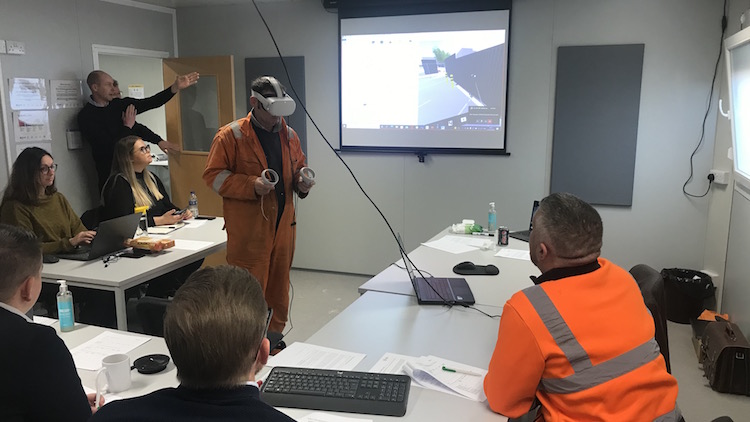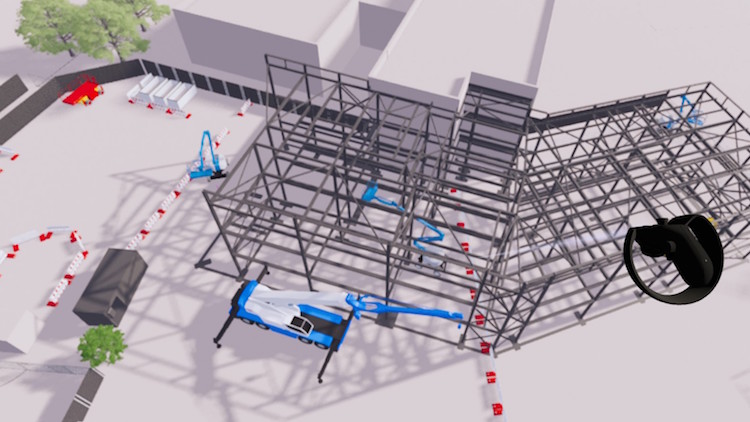
Yorkshire-based SME contractor Sewell Construction has tested VR tools for the first time. Key staff gave their feedback to Mark Swallow MCIOB Tech IOSH, senior lecturer in construction project management at Sheffield Hallam University.
Planning logistics and communication remains an essential aspect of effective safety management. Methods to achieve this often involve reliance on traditional means that can lead to misinterpretation. The integration of virtual reality (VR) tools to existing processes can offer an immersive approach to logistics planning and the communication of safety risk, and with hardware now a realistic and affordable option, it’s time to address these challenges to drive its widespread adoption.
Yorkshire-based contractor Sewell Construction recently piloted the use of VR within their existing planning and safety workshops at the Boulevard Academy project, Hull. The trial focused on the erection of the steel frame and brought together people from the project team including site managers, commercial managers and trade contractors.
Using the headsets and an on-screen projection, the team navigated the virtual construction model to communicate the site arrangements and discuss the proposed method of works. The trade input and collaboration were invaluable to this planning process through providing opportunities to identify potential risks and exploring means to control them. This included agreeing plant locations, additional temporary works and areas of segregation.
Increasing engagement
VR workshops increased engagement and interest, as Bethany Dennett, community investment champion at Sewell, explains: “I was truly fascinated by the demonstration of the VR on the steelwork. It was so interesting to see the steel frame virtually through the VR prior to physically on site. I found it interesting to learn how health and safety risks may be mitigated through the use of VR in the industry and what benefits this type of technology can bring to construction sites.”
Robert Page, site manager at Sewell, adds: “Using VR has meant we could engage with subcontractors prior to site commencement and build a relationship with operatives before they initiated construction works on site.”

Bringing the team together around a table to explore the project using this immersive environment sparked further conversation. While some within the team were initially unsure of the inclusion of the technology, individuals began to see potential benefits this could bring to their role as the workshops progressed.
Peter Martin, quantity surveyor at Sewell, remarks: “My first initial thoughts on VR were sceptical. However, after attending the sessions, my opinion has changed completely. I believe VR is an inexpensive piece of technology that can benefit all areas of the industry. Whether it is a bid manager preparing a client presentation, a QS rationalising a scope with a subcontractor or a site manager highlighting safety concerns to on-site operatives. Used in the correct manner, the possibilities can be endless”.
Collaborative and safe environment
Trialling the use of VR to support the collaboration of the wider project team was seen as a positive addition to the planning process. Page adds: “As a forward-thinking company, with digital construction a main focus for us, it is important for us to explore VR and all it has to offer. It has given us access to view our construction site up close and personal, but without the associated risks.
“This gave us a collaborative safe environment to work within, which enabled us to explore changes to the built environment and forge a superior sequence for, in this instance, the steel frame erection. Working in the same room as the steel fabricators highlighted the potential of information becoming lost in translation and how VR gives you a visual platform to pinpoint directly what part of the structure may need to be better understood. With the headset and a projector screen, we were able to discuss site layouts, erection sequencing and allow the critical path to flow by removing ever-present bottle necking.”
Having workshops on site in a live project environment using VR in this way, Sewell has identified the potential to embed this technology further within their projects. The overall positive experience from the organisation including the wider project team shows there are real benefits to the inclusion of this technology.
Mark Boothby, joint MD at Sewell Construction, notes: “As a business, we’re passionate about the benefits digital technology can have on the construction industry, having been involved with BIM for several years. Having the opportunity to explore the benefits of BIM and VR in the safe planning and delivery of high-risk operations by bringing into the process the people who’ll be carrying it out has resulted in a safer, more innovative approach to the delivery.”
There are opportunities to integrate these evolving forms of immersive technology into forward thinking construction companies… It’s all about realising the potential and taking the next steps to digital transformation to improve project delivery.
Don’t miss out on BIM and digital construction news: sign up to receive the BIMplus newsletter.












